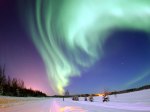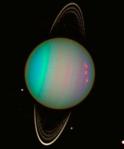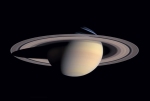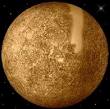Charae and Bryce take us on a trip into spacetime, with a song about everything they’ve learned from Astrofacts, to the tune of Rihanna’s Disturbia.
Listen here [2:50m]:
Download here [2.7 Mb]: ftp://space.mit.edu/pub/ajb/radiopio/astrofacts_090730_spacetime.mp3
What’s the Facts:
Charae & Bryce have put together a song that’s rich in astrofacts. Let’s break down the lyrics to see what they will encounter on their trip into spacetime.
Lyrics:
Mercury, Venus, Earth, Mars, Jupiter, Saturn, Neptune, Uranus, Plut-
Whao! Hold up. Not Pluto.
What?!? Not Pluto?
Yeah, Not Pluto.
I’m goin’ crazy now
Here’s our planets of the Solar System, up to Pluto, which has been “reclassified” as a dwarf planet. Pluto might be feeling a bit down about it, and plenty of people are not happy either! By the way, Neptune comes after Uranus, our mistake!
To the moon in this ship,
We’re gonna get it started,
Fuel tanks filled to the rim,
Discover the uncharted,
Breaking through atmospheres,
It’s not for the fainthearted,
We’re gonna go into space, yeah
Want to go into space? Be prepared for an explosive ride! You only need enough force to overcome Earth’s gravitational pull to go toward space – which you can do briefly by jumping! But to sustain the upward trajectory requires lots of fuel and thrust. The rockets that carry the Space Shuttle have a combined thrust of 13 million Newtons – 20,000 times the force you exert when jumping – to lift the 4.5 million pounds (2 million kg) that hold 7 lucky astronauts!
It’s real hot on the Sun,
Forgot my sunscreen,
It’s definitely hot on the Sun – 9,800 degrees Farenheit! That’s so hot that everything is essentially evaporized on the surface, and atoms are even stripped of their electrons to form a 4th state of matter called plasma.
The day’s long here on Mars,
I need some caffeine,
A day on Mars take 24 hours, 39 minutes, and 35 seconds – about 3% longer than that of Earth. So it’ a little longer, but you’ll adjust.
2.9 times 10 to the 13
Miles a minute, I’m carsick.
That’s a pretty big number, and one would hazard to guess that it’s the speed of light. However, the speed of light is only about 11 million miles per minute. 290,000,000,000,000 miles is about 5 light-years, a little further than the nearest star to the Sun, Alpha Centauri. If you could do that in a minute, you would certainly be carsick!
We’re in great heights,
In one of Saturn’s rings, yeah
You ain’t go bling like mine,
Meteors made for kings,
We watch the stars shine,
From Polaris to Betelgeuse,
The universe is mine.
Some of the most beautiful things in our Universe! Saturn’s rings are definite bling, comprised of small particles of water ice and dust that are extremely reflective – that’s why Saturn it so bright despite being further from the Sun than Jupiter. Meteors are of course another dazzling night sky event, while Polaris (the North Star, in the constellation Ursa Minor, or Little Bear) and Betelgeuse (in Orion’s armpit!) are two of the brightest stars in the sky.
We’re all in Space-time,
Two words in one continuum,
Space-time,
1, 2, 3, 4 Dimensions,
Your mind’s in Space-time
Beyond comprehension,
Space-time, Space-time.
Space-time is that idea of three-dimensional space (length, width and height) combined with one-dimensional time as the “framework” of the Universe. You probably already think this way, as in “I need to get to the third floor of the building on the corner of Main and 1st Avenue at 3pm”. These dimensions appear to be completely separate in our slow, small-scale world, but when you travel close to the speed of light, or near a massive object like a black hole, Einstein’s theory of general relativity tells us that the continuum of space and time can get mixed up, resulting in some bizarre effects!
There’s a guy in the sky,
His names Orion,
Not a man, he’s made of stars,
Emitting carbon.
This refers to the massive giant star Betelgeuse in Orion, which is currently losing mass and size as it sheds its outer atmospheric layers. It will eventually supernova, releasing many elements such as carbon into space. It is all part of the cycle of life in the Universe, as the elements shed from stars like Betelgeuse when they die make their way to form other stars, planets and even people!
Acid rain falls,
It burns my eyeballs.
Venus lighting strobe light.
Remember our weather report from Venus? Acid rain doesn’t quite make it the surface of the planet, but there are plenty of lightning strikes that might make the surface of Venus feel like a disco!
Lots of holes out in space,
They try to grab you,
They can creep up behind you and consume you,
Not even light can escape,
Nothing can breakthrough,
Spa-ghe-tti-fi-ca-tion.
Black holes are the massive remnants of stars that are so dense that nothing, not even light, can escape being swallowed up. If you’re not careful you’ll get pulled into it and never come out again. And on the way in you’ll get stretched out long and slender, like spaghetti. That’s called spaghettification!
We’re in great heights,
In on of Saturn’s rings, yeah
You ain’t go bling like mine,
Meteors made for kings,
We watch the stars shine,
From Polaris to Betelgeuse,
The universe is mine.
We’re all in Space-time,
Two words in one continuum,
Space-time,
1, 2, 3, 4 Dimensions,
Your mind’s in Space-time,
Beyond comprehension,
Space-time, Space-time.
Lyrics by Charae and Bryce










